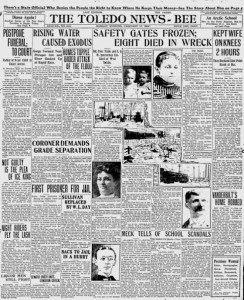“It’s a scene that will haunt me for many years to come. I’ve seen some bad disasters, but last night was the worst.”
With those words to a News-Bee reporter, an aged railroad crossing flagman, J.F. Kimball, described the night of February 15, 1908 when a Toledo and Western Railway interurban car was struck by a Big Four train at the Phillips Avenue crossing about 8:10 p.m.

Eight people died and sixteen were injured.
The conductor, Wilbur Potter, told the News-Bee the interurban stopped west of the tracks and he went ahead to signal. Potter said he signaled the car to stop as a freight train obstructed his view, but the interurban crossed the tracks anyway and was hit dead center by the Big Four flyer, No. 312.
“Not the hint of a warning did the passengers in the car get before the terrible crash came,” said W.E. Chapple, Sylvania Postmaster. “As the car came to the Michigan Central tracks it was evident that some of the passengers seen the headlight of the passenger sweeping down upon us, for there was for an instant a shuffle of uneasiness in the car. It was only for the fraction of a second, and then the terrible crash came.
“The first sensation I felt was that of an uplifting force. Moses Beckwith sat in the seat with me, and the next thing I realized was that were being hurled through space, hearing the crunching and grinding of wood and the moans and screams of passengers.”
“I was dumbfounded when I saw the electric car coming, for I knew that it would surely be struck,” said flagman Kimball, who was on duty only because the crossing gates had been frozen out of operation by ice and slush. The accident wouldn’t have happened had the gates been operating properly, the News-Bee concluded.
First estimates placed the speed of the train at 60 MPH, but eyewitness accounts later cut that estimate in half. The interurban was cut in two and tossed up the track 100 feet. Local residents and train employees helped right the car and free the survivors, and later the splintered sections of the interurban were burned so that by midnight nothing was left but twisted iron.
Throughout the evening Saturday and then on Sunday, scores of people came to view the wreckage:
It was a morbidly curious crowd in the main, and jests were hurled back and forth as men, women and children viewed the fragments of the wreck. Pieces of timber, scraps of iron, and even bones of the victims were collected as souvenirs of the horrible catastrophe.
A disgusting scene was witnessed when two young women elegantly attired, struggled for the possession of a piece of blood-stained cloth, which had been the part of one of the victim’s wearing apparel.
All agreed it was a miracle anyone survived. The track owners, the Michigan Central Railroad, blamed the interurban crew entirely for the wreck. A coroner’s inquest later in the week heard testimony that motorman James Myers, who was killed instantly, ignored the signals of both the conductor and the flagman.
“Everything looked clear,” Big Four engineer George Pimlock said at the inquest, “until the car bobbed in front of me. The appearance of the car and the collision were almost simultaneous. Just like this,” he added, snapping his fingers twice.
Many of the dead and injured were Sylvania residents. Among those who survived was the mayor of Sylvania, John C. Jones, who lived into his 90s, according to this 1950 article.
As an aside, the Toledo and Western Railway, which continued in business until 1935, is a good example of the rise and fall of electric interurban lines, single-car rail systems that linked cities and small towns (like Sylvania) before widespread use of the automobile and decent roads came to pass.
The T&W began in Sylvania in 1900 on the site of Sautter’s Food Center on Main St., where an Ohio Historical Society sign marks the spot (you can read what it says here). It ran a line out to Pioneer, Ohio, another to Adrian, Michigan, and also linked to Toledo’s streetcar lines. It’s not to be confused with the Toledo, Angola and Western Railway, which is probably worth a little post all its own.
A month later, the state railway commission recommended strengthening the laws relating to the elimination of crossings, and asked governor for the power to compel the installation of warning devices and signals for electric lines. That story was relegated to the back pages of the News-Bee along with items such as this one:
Here’s the site of the wreck today, from Google maps.
This is a terribly tragic story, and when I pulled back from writing this post, I thought, “Why write about this at all? Who would remember?” The answer to the latter is absolutely no one, except maybe fans of interurban accidents. The answer to the former is a bit more difficult. It’s easy to take for granted the great number of safety devices today that didn’t exist 100 years ago, like railroad crossing gates that work in the winter, or the elimination of railroad grade crossings entirely, and since we don’t ride interurbans anymore, even everyday automobiles are about a million times safer than they were even in the 1960s.
Even in 1917, Ohio’s 48 interurban lines killed 103 and injured 1,219 passengers, highway travelers, employees or trespassers (link, jump to page 518). Not exactly safe. Maybe we should all be thankful interurbans faded as fast as they did.


Compare those numbers to automobile accidents and you were much safer on the trolley.